|
Ernest
Alfred
Foley
1868-1926
|
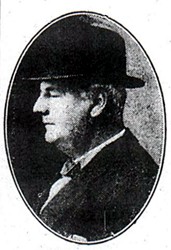 |
The location of Bourne in the middle of a farming area was ideal for an engineer in the burgeoning industry of agricultural machinery and Ernest Foley saw it as a great business opportunity during the late 19th century. When Arnold Pick died and his business at No 30 North Street came up for sale, he and his
elder brother George bought it and moved from Driffield in Yorkshire in April 1891 to begin their new career.
Pick was a local man who had begun his working career as a shoeing smith with premises in Star Lane, now Abbey Road, but later moved to North Street where he established a sound reputation as an ironmonger and blacksmith. He was interested in agricultural machinery, but only in a small way, and it was this that the brothers began to expand and eventually made it one of the biggest enterprises of its kind in Lincolnshire.
George William Foley died prematurely in the spring of 1903 at the age of
34, when Ernest became sole proprietor and by
the early 20th century, he was a familiar figure at the region's
agricultural shows and soon had business connections in all parts of the
country. He was also an engineer of some skill and was the inventor and
manufacturer of a straw elevator, the height of which exceeded that of any
other make on the market and was therefore in great demand.
The ironmongery department continued at No 30 North Street
as a separate undertaking under the direction of a new partner, Mr Henry
Percy Butler. This became a highly successful business, trading under the
name of Foley & Butler, and dealing in a wide variety of articles. An
advertisement of 1909 tells us that they are "general and furnishing
ironmongers, furniture dealers and cycle agents, holding a large stock at
very low prices, also guns, ammunition, furniture, bedsteads and bedding,
grates and ranges of every description, new and second hand cycles of all
makes, motor cars for hire and garage facilities".
But Foley himself also developed and sold threshing
machines, concentrating this side of the business at premises in
Meadowgate which he considerably expanded and in 1920, he bought a massive
80 feet long World War I balloon hangar from the War Department for £400
after it had been declared redundant at the Royal Air Force base at
Wittering, near Stamford.
|
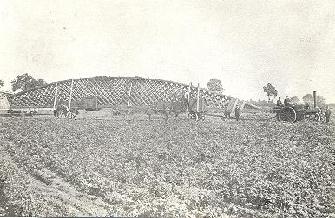 |
 |
|
One of the roof trusses after arrival in
Bourne (left) and the hangar after it was rebuilt can be seen behind
the engines (right). |
It was then dismantled and transported to Bourne in
sections by road, an operation that was not without its difficulties
because the load was the longest ever known to have been transported in
this part of the country. The sections included two roof trusses 115ft.
long and two doors 30ft. high. Among the workmen employed by Foley at that
time was George Hollingsworth of Bourne, who worked as a boilersmith
apprentice, and in 1960, he recalled the operation to shift the hangar
from Wittering to Bourne:
The two trusses were secured side by side on
ex-army horse-drawn wagons, the fore carriage and rear axles used
respectively. The built up draw bar was 27 feet long. The truss at the
back was damaged when the lifting derrick collapsed, scraping the tender
of the engine when it fell. The engine was a Foster Wellington tractor,
again ex-war surplus. I was the driver working with the wire rope
contained on a windlass inside the left hand rear wheel of the engine. We
took it to Foley's yard in Meadowgate on what was then the water cress
beds between Harrington Street and George Street, although neither of
these streets existed at that time. The doors were transported upright and
when passing down High Street St Martin's in Stamford, the gallows sign
across the road should have been removed by the proprietor as had been
previously arranged but it was still in position and was far too low for
the doors to pass underneath. But the load was being moved under police
escort who gave the order to carry on and so the sign which was carried on
the beam was wrenched from the stonework with devastating results. There
was another mishap in Wharf Road on the incline into Priory Road where the
wheels on the engine slipped and, as was customary, the load was scotched
and unhitched and the engine went forward while the wire rope from the
engine's winding drum was run back and the hook attached to to the draw
bar. As the load progressed up the incline, one wheel of the fore carriage
encountered an unnoticed manhole cover, causing the fore carriage to swing
round and the hook fell out of the eye of the draw bar, allowing the load
to run backwards in Wharf Road, demolishing a wall on the way. It was
rebuilt with Mr Foley paying the bill and ever afterwards he referred to
it as "my wall". The various sections eventually arrived safely and the
hangar was re-erected on site where it was used as a sales and display
area.
Ernest Foley took no prominent part in the public life of the town and had no ambitions to serve as a councillor or in any other official capacity although he was keenly interested in its growth and progress and helped whenever he could.
He was a staunch Methodist and loyal supporter of the chapel in Abbey Road
where he was appointed a trustee in 1897. The chapel at this time was lit
with oil lamps and candles but in 1907, ever ready to help financially,
Foley paid for them to be replaced by gas lighting and the proposed change
was recorded in the minutes of a meeting of the trustees on February 6th:
"Mr E A Foley made a provisional offer to re-light the chapel with
incandescent burners. After considering the offer, it was decided that it
be carried out, and that Mr Arnold [Robert Arnold, a Bourne tradesman and
Methodist trustee] be instructed to have the schoolroom fitted up in the
same way at the expense of the Trust." Permission was finally given
for the scheme to go ahead on 11th October 1907.
|
 |
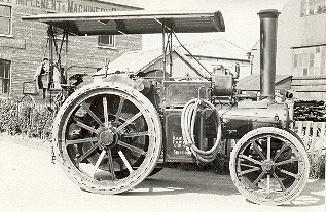 |
|
The extent of Foley's business activities
may be judged by these two machines, photographed by Ashby
Swift outside the firm's premises in Meadowgate before being sold to local
customers. The traction engine on the left was made by Fowler of Leeds and
was part of a consignment originally built for Russia for mechanised
ploughing but the order was cancelled as a result of the revolution
of 1917 and the engines sold to the government for use by the
army before being sold off. Foley bought ten of them and all were
snapped up as mechanisation took hold on local farms. The Wellington
tractor on the right, made by Foster of Lincoln, was one of a
consignment of 200 bought by Foley from the War Department and which
also found ready customers among farmers in the South Lincolnshire
area. |
Foley
devoted himself almost entirely to his engineering work and to the chapel
except for one weakness that he had for the moving pictures, then a novelty entertainment that had just arrived in Bourne, and he and Butler secured an agreement with the company that ran the Corn Exchange for the use of the hall as a cinema, a facility that continued until his death which, like his brother George, was also
unexpected.
He visited Harrogate Show on Saturday 24th July 1926 and returned by train to Peterborough where he
called in at the market and met several old friends before catching the afternoon bus back to Bourne. He arrived at his home at Claremont, North Road, about 5 p m and, after having his tea, complained of not feeling well and went upstairs and soon afterwards, his wife heard a thud and rushed upstairs to find him vomiting and called the doctor but he died within a few minutes. He was 58 years old and an inquest decided that he had died from cardiac syncope.
Foley came from a very old Wesleyan [Methodist] family and had maintained close ties with the church
in Abbey Road since moving to Bourne. He was also a member of the Hereward Lodge of Freemasons. He had married twice, his first wife being the daughter of
Mr George Mays, a director of the Mays family fellmongering and fertiliser business, but
she died in July 1914 at the age of 53 after being confined to her bed for
three months. His second wife survived him, together with two young
daughters.
The funeral was divided into two parts, the first a private ceremony at Foley's home for members of the family, and afterwards at the town cemetery, both conducted by the Vicar of Bourne, the Rev John Grinter and the Wesleyan circuit minister, the Rev J H Tite. As the funeral cortege passed from the house to the cemetery, the blinds at all of the private houses along the route were drawn, business establishments closed and all trading
was suspended. His coffin was borne by eight employees and was deposited in a vault of white, glazed bricks and as the graveside service ended, fellow
Freemasons dropped sprigs of acacia into the grave. The plot in the
cemetery was never purchased by his executors and no tombstone was erected to mark his grave.
As a result of the fifty-year rule governing cemeteries, it was subsequently sold and it is now occupied by Mrs
Josephine Moisey, aged 59, (died 1981) and her husband Reg, aged 90, (died
2002), who are buried on top without disturbing the original grave.
|
After his death, the business was sold and in March 1928,
his entire stock of agricultural machinery and haulage plant, comprising
almost 800 lots, came under the hammer at an auction sale on the premises.
The gap in the market was subsequently filled by a young man who had been
employed as a clerk at Foley's Agricultural Engineering Works, Mr Thomas
Rickard, who established his own business on the site as T Rickard and
Sons Ltd., implement agents, Hereward Works, which continued in existence
until the middle years of the 20th century.
|
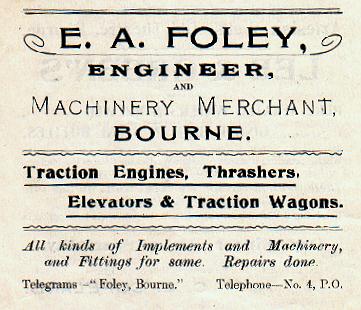
|
Foley is now largely forgotten in Bourne although occasional advertisements in town guides and other publications
survive such as the one pictured above from 1909.
|
PHOTO ALBUM |
|
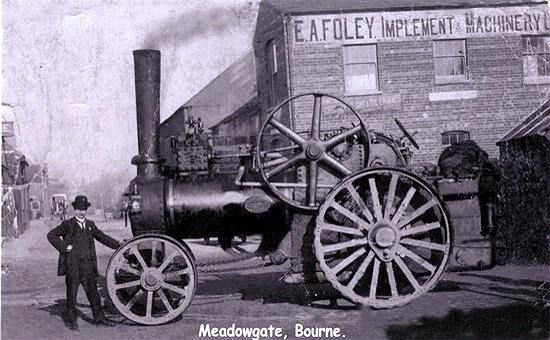 |
|
One of the steam traction engines sold by Ernest
Foley's company pictured in Meadowgate with Mr George Frost, the firm's
accountant (above), and the sale of vehicles and equipment held near the
company's premises on 27th and 28th May 1903 (below) following the
premature death of co-owner George William Foley that year at the age of
34, making Ernest the sole proprietor. |
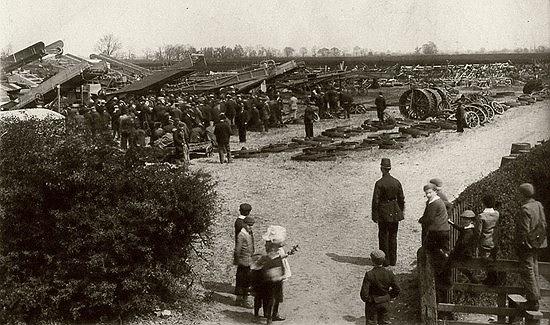 |
|
The shop premises at No 30 North Street
where Ernest Foley and his brother George started in business in April
1891 after the death of the previous owner, Arnold Pick, ironmonger and
blacksmith. The ironmongery department continued as a separate
undertaking under the direction of a new partner, Mr Henry Butler, and
became a highly successful business, trading under the name of Foley &
Butler, and dealing in a wide variety of articles.
The property is now part of the Jubilee
Garage public house and the frontage has been preserved in its original
state by the new owners. |
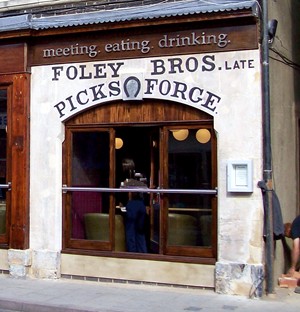 |
|
GEORGE W FOLEY 1868-1903
George W Foley was the senior partner of his brother, Ernest Foley, who
established the successful business of Foley Brothers in Bourne during
the late 19th century, his particular speciality being the engineering
department which was run entirely under his supervision.
He regularly attended the Methodist Chapel in Abbey Road although
failing health in later years prevented him from taking a prominent role
in their activities. He was known to have a weak heart although he
appeared to have improved in recent weeks but despite going to
Peterborough on business and then attending an implement and machinery
sale in Bourne the previous day, he was taken ill at his home in North
Street on the morning of Friday 16th January 1903 where he later died.
Mr Foley left a widow, Sarah (née Sharman), who he had married
at Edenham parish church on 23rd September 1896.
The funeral was held at the Methodist Chapel the following Monday when
all businesses along the route closed and the blinds drawn at private
houses as the cortege passed as a mark of respect. The chapel was packed
for the service with leading shopkeepers, councillors and members of the
business community and many also attended the graveside in the town
cemetery where he was buried. The floral tributes included one from his
employees by whom Mr Foley was highly respected and who all attended the
service. |
See also
Ernest Foley -
engineering pioneer
Farming in past times Thomas Rickard

Go to:
Main Index Villages
Index
|








